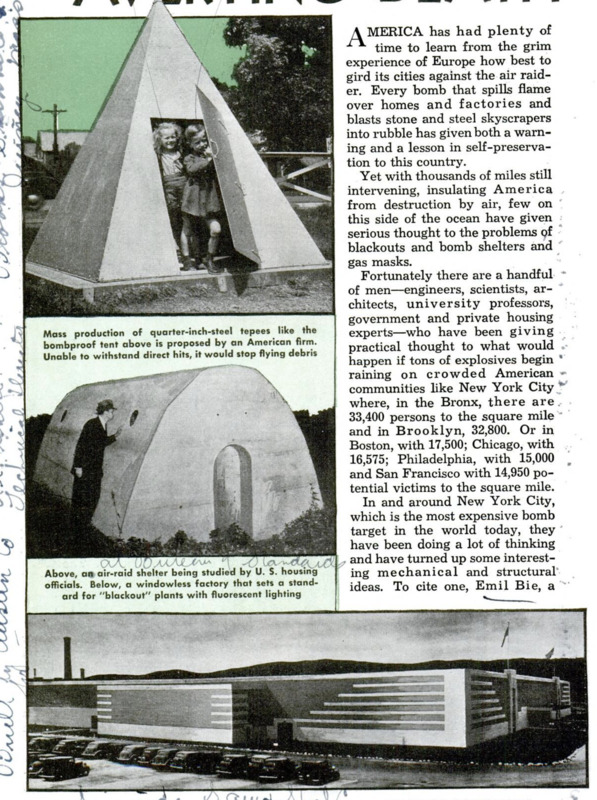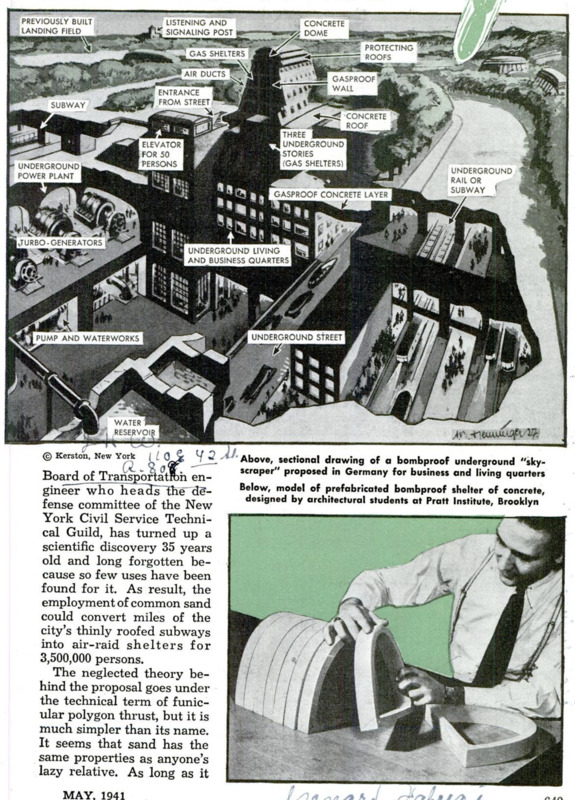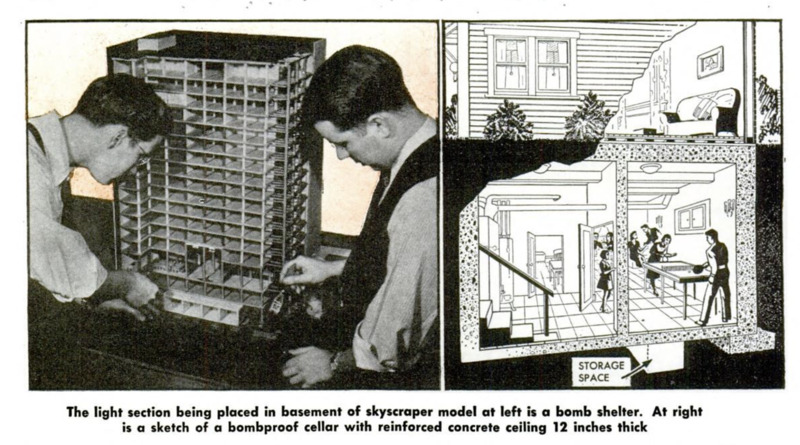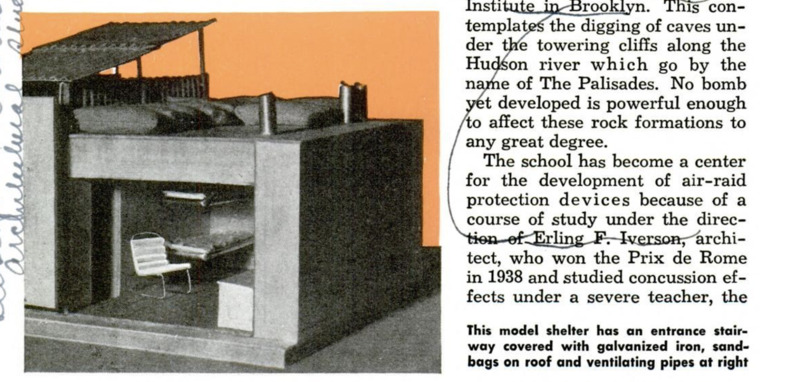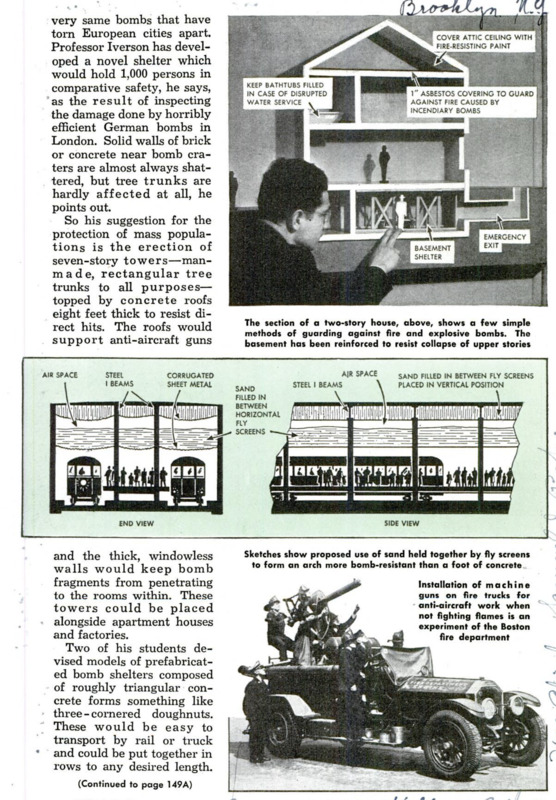AMERICA has had plenty of time to learn from the grim experience of Europe how best to gird its cities against the air raider. Every bomb that spills flame over homes and factories and blasts stone and steel skyscrapers into rubble has givenboth a warning and a lesson in self-preservation to this country. Yet with thousands of miles still intervening, insulating America from destruction by air, few on this side of the ocean have given serious thought to the problems of blackouts and bomb shelters and gas masks. Fortunately there are a handful of men - engineers, scientists, architects, university professors, government and private housing experts - who have been giving practical thought to what would happen if tons of explosives begin raining on crowded American communities like New York City where, in the Bronx, there are 33,400 persons to the square mile and in Brooklyn, 32,800. Or in Boston, with 17,500; Chicago, with 16,575; Philadelphia, with 15,000 and San Francisco with 14,950 potential victims to the square mile. In and around New York City, which is the most expensive bomb target in the world today, they have been doing a lot of thinking and have turned up some interesting mechanical and structural ideas. To cite one, Emil Bie, a Board of Transportation engineer who heads the defense committee of the New York Civil Service Technical Guild, has turned up a scientific discovery 35 years old and long forgotten because so few uses have been found for it. As result, the employment of common sand could convert miles of the city’s thinly roofed subways into air-raid shelters for 3,500,000 persons. The neglected theory behind the proposal goes under the technical term of funicular polygon thrust, but it is much simpler than its name. It seems that sand has the same properties as anyone's lazy relative, As long as it is supported, it is no stronger than the support. But if the support is removed, the sand packs down, forms an arch and supports itself. Sand is shoveled onto a thin, bending corrugated metal sheet which only keeps it from sifting through. The area above the metal sheet for a foot or so has been divided by vertical walls of ordinary fly screen and an occasional “I” beam. Above this, horizontal walls of the same fly screen divide the sand into layers for four or five feet. Whereupon the sand produces a remarkable phenomenon. Laboratory experiments have shown that a slab of loose sand and fly screen three feet wide and four to five feet deep, confined at the sides and unsupported from beneath, can resist a vertical load of more than 3,000 pounds per square foot and is more valuable in resisting concussion than afoot of reinforced concrete. It happens that many subway stations have an intermediate, or mezzanine, floor between the platforms below and the streets above. Installing rows of 14-inch “T” beams, laying strips of corrugated metal, soldering in fly screen and shoveling sand into the mezzanine of compartments promises to be a cheap method of saving thousands of lives if the need arises. Another practical, but costly, suggestion for the protection of millions has been put forward by architectural students of Pratt Institute. This contemplates the digging of caves under the towering cliffs along the Hu river which go by the nashe of The Palisades. No bomb yet developed is powerful enough affect these rock formations to any great degree. The school has become a center for the development of air-raid protection devices because of a course of study under the direction of-Erling F. Iverson, architect, who won the Prix de Rome in 1938 and studied concussion effects under a severe teacher, the very same bombs that have torn European cities apart. Professor Iverson has developed a novel shelter which would hold 1,000 persons in comparative safety, he says, as the result of inspecting the damage done by horribly efficient German bombs in London. Solid walls of brick or concrete near bomb craters are almost always shattered, but tree trunks are hardly affected at all, he points out. So his suggestion for the protection of mass populations is the erection of seven-story towers - man-made, rectangular tree trunks to all purposes - topped by concrete roofs eight feet thick to resist direct hits. The roofs would support anti-aircraft guns and the thick, windowless walls would keep bomb fragments from penetrating to the rooms within. These towers could be placed alongside apartment houses and factories. Two of his students devised models of prefabricated bomb shelters composed of roughly triangular concrete forms something like three-cornered doughnuts. These would be easy to transport by rail or truck and could be put together in rows to any desired length. Another school producing ideas for bomb shelters is the Newark College of Engineering, where Professor Odd Albert has designed what he calls the “Bompus-Rumpus Room” because it is a place where “bombs won’t raise a rumpus.” He suggests that every new home be equipped with such underground rooms. The cellar could be utilized to the full area covered by the building. The ceiling of the shelter could be reinforced concrete, 12 inches thick, with beams of the same material, 12 inches wide and 24 inches deep. This bombproof cellar might be divided into three parts, one for living, one for sleeping, the third as the utility room. Such construction would be fireproof. It would carry a load of over 1,000 pounds per square foot as compared with a required design load of 60 pounds per square foot, which is the strength of present-day floors. Therefore, even if a building with a bomb cellar is wrecked or burned down to the ground, the cellar will be intact, as the ceiling construction is strong enough to carry the load of debris of a caved-in building three or four stories high. Factories are especially vulnerable to air attack and are also very important to defense production. Many architects turned their attention to designing efficient wartime production plants, only to discover that this country has been constructing about what would be needed during conflict - low, windowless buildings with fluorescent “daylight” and air conditioning. The new North American Aviation Company plant in Dallas, Tex., adds a couple of innovations to this type of structure. It is only 21 feet high for the most part and the walls are only three inches thick. They are composed of a layer of concrete and two layers of steel, so constructed that they will bend and warp rather than break" if bombed. Entrances are through slide doors and a concrete screen in front of each door protects the interior from bomb fragments. The General Electric Company has perfected a trailer-mounted portable sub- station complete with protective and switching equipment for supplying service quickly at any point on distribution circuits where emergency service is required. And the Boston fire department is ex- perimenting with machine guns mounted on fire trucks so that they may be rushed to fight off planes when not busy fighting fires. In New York, fire authorities are studying a trailer fire pump designed to meet the threat of incendiary bombs. The advice given to civilians in a city under an air raid is to avoid panic and get in off the street; walk to the nearest subway or the lobby of a steel or concrete building. Top and bottom stories and elevators should be avoided; cellars are safe only in low, well constructed buildings. If you're at home, the best advice is to close the windows, pull down the shades, extinguish all lights - turn off gas and electric connections - and don’t smoke, light matches or eat until danger is past. America is far from the danger zone, but the time to prepare is before the emergency.
